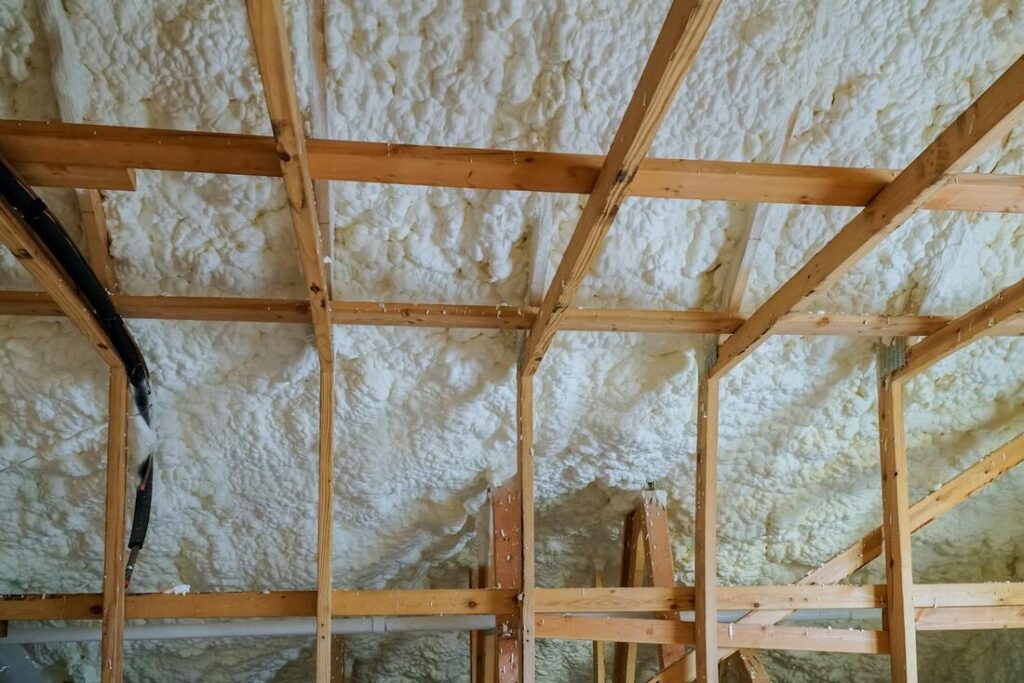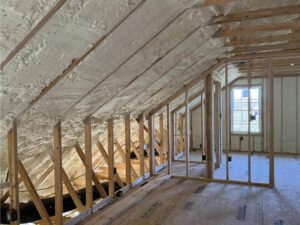Tarrytown homeowners successfully preserve their historic properties’ architectural integrity while achieving modern energy efficiency through strategic spray foam insulation applications. The key lies in selecting closed-cell spray foam for foundation and rim joists, combined with open-cell foam in wall cavities where expansion won’t damage original materials. This approach maintains the home’s breathability while creating effective thermal barriers that reduce energy costs by 30-50% without compromising structural elements or period-appropriate features.
These historic preservation projects require careful material selection and application techniques that respect original construction methods. Professional installers focus on areas where modern insulation provides maximum benefit with minimal visual impact, ensuring century-old homes meet contemporary comfort standards while retaining their authentic character. With proper installation, spray foam insulation transforms drafty historic homes into energy-efficient living spaces that honor their architectural heritage.
Understanding Historic Home Insulation Challenges
Historic Tarrytown homes present unique insulation challenges that differ significantly from modern construction. Original building methods prioritized natural ventilation and seasonal temperature variations, creating homes with inherent air movement that modern occupants often find uncomfortable. These structures typically lack built-in insulation systems, relying instead on thick masonry walls, high ceilings, and strategic window placement for climate control.
The primary challenge involves balancing preservation requirements with energy efficiency goals. Many historic properties feature original materials that must remain undisturbed, limiting insulation placement options. Additionally, moisture management becomes critical since historic homes were designed to “breathe” naturally, and improper insulation can trap moisture that leads to wood rot, mold growth, and structural damage.
Strategic Spray Foam Applications for Historic Properties
| Application Area | Foam Type | Primary Benefit | Preservation Consideration |
| Basement/Foundation | Closed-Cell | Moisture barrier, structural support | Protects original stone/brick foundations |
| Rim Joists | Closed-Cell | Eliminates air infiltration | Hidden application preserves aesthetics |
| Wall Cavities | Open-Cell | Breathable insulation | Allows natural moisture movement |
| Attic Spaces | Open-Cell | Cost-effective coverage | Maintains roof ventilation systems |
| Crawl Spaces | Closed-Cell | Complete air sealing | Prevents ground moisture intrusion |
Successful historic home insulation requires targeting specific areas where spray foam provides maximum impact without compromising architectural integrity. Foundation applications prove most effective since basements and crawl spaces rarely contain decorative elements requiring preservation. Closed-cell foam applied to foundation walls creates an impermeable moisture barrier while providing structural reinforcement to aging masonry.
Rim joist insulation delivers exceptional results in historic homes since these areas typically experience significant air leakage. The application remains completely hidden while eliminating drafts that plague many older properties. According to the Department of Energy, rim joist insulation alone can reduce heating costs by 15-20% in homes built before 1950.
Technical Specifications and Performance Data
| Specification | Open-Cell Foam | Closed-Cell Foam | Traditional Fiberglass |
| R-Value per inch | 3.5-3.8 | 6.0-7.0 | 2.2-2.7 |
| Vapor Permeability | 16+ perms | <1 perm | 5-10 perms |
| Expansion Rate | 100:1 | 30:1 | N/A |
| Moisture Resistance | Moderate | Excellent | Poor |
| Application Thickness | 3-5 inches | 1-3 inches | 3-6 inches |
| Cost per sq ft | $1.50-$2.50 | $2.50-$4.00 | $0.75-$1.25 |
The performance characteristics of different spray foam types determine their suitability for historic home applications. Open-cell foam’s higher permeability allows moisture vapor transmission, making it ideal for wall cavities in historic homes that require breathability. Its lower expansion pressure reduces stress on aging building materials while still providing effective air sealing.
Closed-cell foam’s superior moisture resistance and structural properties make it perfect for below-grade applications and areas requiring maximum thermal performance. Its ability to add structural strength benefits aging foundations and floor systems common in historic properties.
Bonus Tip: Test small, inconspicuous areas first when applying spray foam near original materials. Historic woods and plasters may react differently to foam expansion than modern materials, requiring adjusted application techniques.
Climate-Specific Considerations for Texas
Central Texas climate patterns significantly influence insulation strategies for historic Tarrytown homes. The region’s hot, humid summers and mild winters create specific challenges for moisture management and thermal control. High humidity levels during summer months can drive moisture into building assemblies, making vapor-permeable insulation systems essential for preventing condensation issues.
Historic homes in this climate zone benefit from insulation strategies that address both cooling and heating loads. Summer heat gain through roofs and walls requires attention to thermal bridging, while winter heating demands focus on air sealing to prevent drafts. The moderate heating season means cost-effective open-cell foam applications often provide sufficient thermal performance without requiring premium closed-cell products throughout the entire structure.
Local building codes and historic preservation guidelines also influence insulation choices. The Texas Historical Commission requires specific approvals for modifications to registered historic properties, making professional consultation essential for major insulation projects.
Things to Consider Before Making a Decision
Property assessment represents the critical first step in any historic home insulation project. Professional evaluation should identify original building materials, existing moisture issues, and structural conditions that might affect insulation performance. This assessment determines which insulation types suit specific areas and whether additional moisture management systems are necessary.
Historic designation status affects project scope and approval requirements. Properties listed on the National Register of Historic Places or local historic registers may require special permits or design review before insulation installation. Understanding these requirements prevents project delays and ensures compliance with preservation standards.
Budget considerations extend beyond initial installation costs to include potential energy savings and property value impacts. While spray foam insulation requires higher upfront investment than traditional materials, the energy efficiency improvements and comfort gains often justify the expense in historic homes where other efficiency measures may be limited by preservation requirements.
Bonus Tip: Schedule insulation work during shoulder seasons (spring/fall) when temperature and humidity levels are moderate. This timing provides optimal conditions for foam curing and allows proper assessment of the building’s natural ventilation patterns.
Professional Insulation Services for Historic Properties
Residential Insulation
Comprehensive insulation solutions designed specifically for historic homes, addressing unique challenges like irregular framing, aged materials, and preservation requirements while maximizing energy efficiency and comfort.
Open Cell Insulation
Cost-effective spray foam solution ideal for historic home wall cavities and attic spaces, providing excellent air sealing while maintaining breathability necessary for older building systems.
Closed Cell Insulation
Premium moisture-resistant insulation perfect for historic home foundations, crawl spaces, and rim joists where superior thermal performance and structural reinforcement are essential.
Commercial Building Insulation
Specialized insulation services for historic commercial properties, including warehouses, office buildings, and mixed-use structures requiring preservation-compliant energy efficiency improvements.
Cellulose Insulation
Environmentally-friendly loose-fill insulation option suitable for historic home attics and wall cavities where spray foam application may not be appropriate or cost-effective.
Attic Insulation
Targeted attic insulation solutions for historic homes, including air sealing, ventilation management, and thermal barrier installation that preserves original roof structure integrity.
Insulation Removal
Safe removal of old, damaged, or ineffective insulation materials from historic properties, including asbestos-containing materials that require specialized handling and disposal procedures.
Crawlspace Insulation
Comprehensive crawl space encapsulation and insulation services designed for historic homes, addressing moisture control, air sealing, and thermal performance in challenging below-grade environments.
Wall Insulation
Specialized wall insulation techniques for historic properties, including injection foam, blown-in materials, and spray foam applications that preserve original wall finishes and architectural details.

Common Questions About Historic Home Insulation
How do I maintain historic character while improving energy efficiency? Focus insulation efforts on hidden areas like basements, crawl spaces, and attics where modern materials won’t affect visible architectural features. Use open-cell spray foam in wall cavities to maintain breathability while achieving significant air sealing improvements.
Will spray foam damage original building materials? Proper application techniques prevent damage to historic materials. Professional installers adjust foam density and application methods based on material age and condition. Always test small areas first and avoid over-application that could stress aging structural elements.
What permits do I need for historic property insulation? Permit requirements vary based on historic designation status and local regulations. Properties on historic registers typically require design review before major modifications. Consult with preservation specialists and local building departments before beginning work.
How much can I expect to save on energy costs? Historic homes often achieve 30-50% energy cost reductions through strategic spray foam applications. Actual savings depend on current insulation levels, air leakage rates, and specific areas treated. Professional energy audits provide accurate savings projections.
Is spray foam insulation worth the investment in an older home? The investment typically pays for itself through energy savings within 3-7 years, while significantly improving comfort and potentially increasing property value. Historic homes often see greater percentage improvements than newer construction due to their typically poor existing insulation.
Frequently Asked Questions
Can I install spray foam insulation myself in a historic home? Professional installation is strongly recommended for historic properties due to the specialized knowledge required for material compatibility, moisture management, and preservation requirements. Improper installation can cause irreversible damage to original building materials.
How long does spray foam insulation last in older homes? Quality spray foam insulation maintains performance for 20-30 years or more when properly installed. Historic homes may experience longer lifespans due to stable structural conditions and protection from weather exposure in applications like basements and crawl spaces.
Will spray foam insulation affect my home’s ability to breathe naturally? Open-cell spray foam allows vapor transmission while providing air sealing, maintaining the breathability historic homes require. Strategic application in specific areas prevents over-sealing that could trap moisture and cause problems.
What maintenance does spray foam insulation require? Spray foam insulation requires minimal maintenance once installed. Annual visual inspections check for any damage or gaps, particularly around areas where building settlement might affect the foam seal. Professional assessment every 5-10 years ensures continued performance.
How do I choose between open-cell and closed-cell foam for my historic home? The choice depends on application location and performance requirements. Use closed-cell foam for moisture-prone areas like foundations and rim joists, while open-cell foam works well for wall cavities and attics where breathability is important. Professional assessment determines the best approach for each area.
Ready to Enhance Your Historic Home’s Comfort and Efficiency
Transform your historic Tarrytown property into an energy-efficient haven while preserving its authentic character through professional spray foam insulation solutions. These proven techniques deliver substantial energy savings and improved comfort without compromising the architectural integrity that makes your home special.
Schedule your comprehensive historic home insulation assessment with Stellr to discover how strategic spray foam applications can reduce your energy costs while maintaining your property’s historic charm. Professional evaluation identifies the most effective insulation opportunities for your specific property and preservation requirements.
Stellr
Phone: (512) 710-2839
Email: [email protected]
Reviewer
Reviewer: Sophia White has 8 years of experience in spray foam insulation. She reviewed this post and gave clear guidance on aligning business messaging with what customers actually care about.





